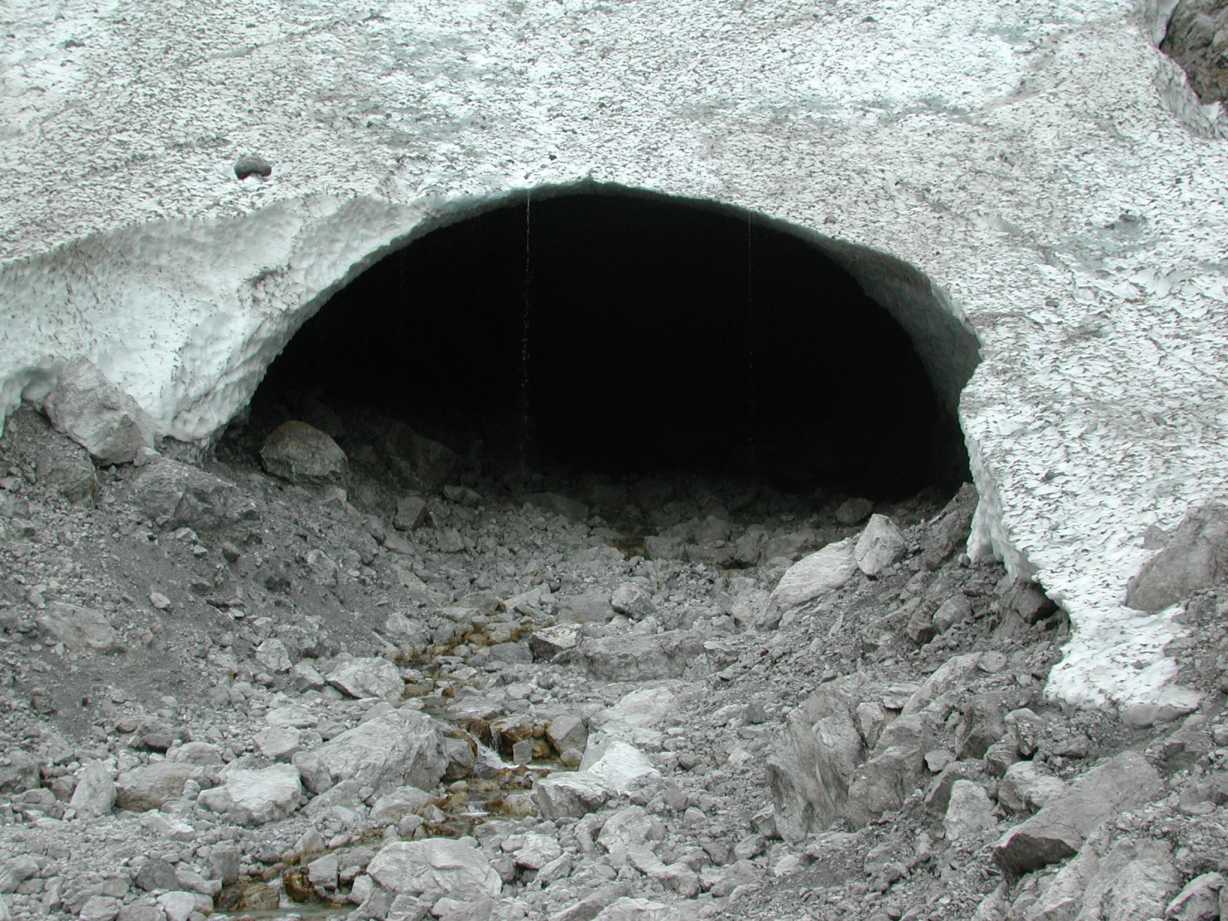 The Eiskapelle is on the base of the
Watzmann-Ostwand, which is 2000 m high, it is the lowest glacial
ice of the eastern alps and it is between 800 and 1000 meters over
the see grade. That is a rarity in the whole alps. It was already
visited by the famous naturalist Alexander v. Humboldt in
1797.
The Eiskapelle is on the base of the
Watzmann-Ostwand, which is 2000 m high, it is the lowest glacial
ice of the eastern alps and it is between 800 and 1000 meters over
the see grade. That is a rarity in the whole alps. It was already
visited by the famous naturalist Alexander v. Humboldt in
1797.
Because of the huge masses of snow, which fall into the cave in
winter, there is snow and ice in the Eiskapelle during the whole
year. Something about 90% of snow comes into the cave with
avalanches, which came down from the Watzmann.
The whole glacial ice is 250 m long and 280 m wide. At the upper
part the thickness of it is almost 90 m. The thickness and
expansion of the ice is connected with the difference of masses of
snow in several years. That is why the Eikappelle is an exception
of the climate change, which is discuss a lot in this times. So
this natural wonder could be visited by visitors of the national
park Berchtesgaden for a very long time in future.
You need 1 - 1,5 hours for the walk to the Eiskappelle from
Bartholomä/ Königssee. It is in an alpine scenery, so good shoes
and save steps are premises for this walk! This is not a cave, in
which you are able to go in, and the visit is very dangerous! I
necessary advise you not to go inside the cave and keep a save
distance to the entrance, because there were already a few people
killed by crashing down of huge pieces of ice.
Please answer the following question:
What effects has the “Albedo-Effekt” to the glacial ice
?
Mail me the answer for logging. Please take a photo of you and your
GPS in front of the Eiskappelle and add it to your log.
Die Eiskapelle am Fuß der 2000 m hohen Watzmann-Ostwand ist das
tiefstgelegene Eisfeld (Gletscher) der Ostalpen und in der
Höhenlage zwischen 800 und 1000 m eine Rarität im gesamten
Alpenraum. Bereits 1797 besuchte sie der große Naturforscher
Alexander v. Humboldt.
Dass sich dieses Eisgewölbe das ganze Jahr hindurch hält, liegt am
außergewöhnlich großen Schneeeintrag. Rund 90 Prozent des
jährlichen Massenzuwachses kommen nämlich als Lawinen aus den
trichterförmigen Felswänden des Watzmann-Massivs.
Der gesamte Eiskörper hat eine Länge von 250 m und eine Breite von
280 m. Im oberen Teil beträgt die Dicke annähernd 90 m. In dem
schneearmen Winter 2006/2007 schmolzen rund 690.000 Kubikmeter
Schnee und Eis ab, während im darauffolgendem Winter regelmäßige
Schneefälle die Schmelzverluste mehr als wett machten. Daher war
die Schneedecke auf der Eiskapelle im Mai 2008 um durchschnittlich
9,4 m höher als im Vorjahr. Die hohe Variabilität des Schneefalls
entscheidet über Ausdehnung und Dicke des Eisfeldes. Die Eiskapelle
ist somit ein Sonderfall, der vom viel diskutierten Klimawandel
abgekoppelt ist. Daraus ergibt sich die erfreuliche Aussicht, dass
dieses Naturwunder den Besuchern des Nationalparks Berchtesgaden
noch sehr lange erhalten bleibt.
In gut 1 bis 1 1/2 Stunden Wanderweg ab St. Bartholomä / Königssee
kann die Eiskapelle erreicht werden. Wir befinden uns hier in
alpinem Gelände, d.h. dass gutes Schuhwerk und Trittsicherheit
Vorraussetzung sind! Sie ist keine Schauhöhle und der Besuch ist
sehr gefährlich! Ich rate dringend davon ab die Höhle selbst zu
betreten. Bitte bewahren Sie unbedingt einen Sicherheitsabstand vom
Eingangsportal, da es hier durch herabstürzendes Eis bereits Tote
gegeben hat.
Bitte beantworte folgende Frage:
Welche Auswirkungen hat der Albedo-Effekt auf den Gletscher ?
Zum Loggen maile mir die Antwort.
Bitte mach ein Foto von dir und deinem GPS vor der Eiskapelle und
füge es deinem Log bei. Du brauchst meine Logerlaubnis nicht
abwarten.